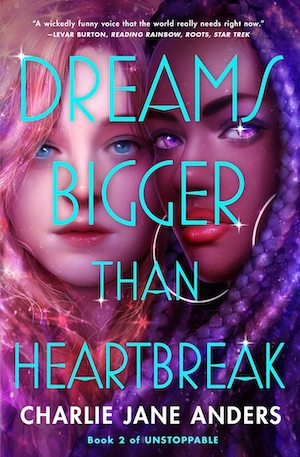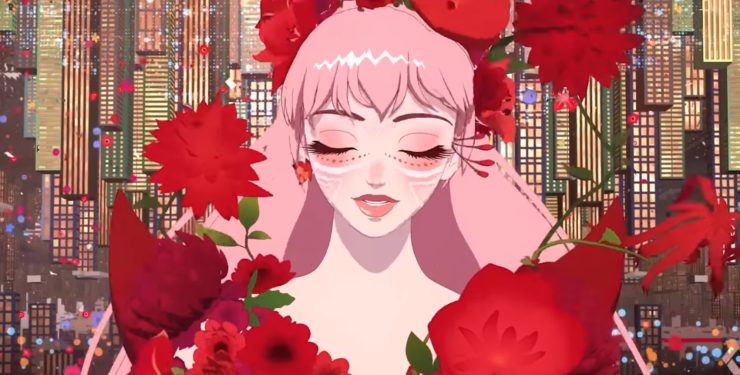It’s really hard to explain why I enjoy Twitter. It’s something like a confessional booth playing at being a community but wrapped up in an extremely artificial package. There is a comfort in that. In knowing that Twitter is something created in indetermination, that in this digital space, it’s easy to erase what you’ve done, to walk away, to change yourself.
In Mamoru Hasoda’s Belle, the main character Suzu creates an account in U—a digital community that’s much like Second Life with some biometric associations tacked on—and transforms from a mild-mannered schoolgirl into an international pop icon, known across the cyberverse as Bell. During a massive concert the Dragon, a beast hunted by U’s digital police, interrupts Bell’s performance. Suzu/Bell then begins a search for his true identity.
[Minor spoilers for Belle below.]
To be clear, Belle is definitely a retelling of Beauty and the Beast. It takes the secret identity motifs at the core of the fable and turns them inside out with threads of trauma and acceptance, making it clear how the put-upon identities in U are masks for the real people behind the personas. The worst thing that can happen in U is what’s called ‘unveiling’ where the digital avatar is stripped away to reveal the real person behind the pixels. For someone like Suzu, for whom U is an escapist fantasy away from her humdrum life, this threat feels existential. For someone like the Dragon, who has his own reasons to hide from the real world, the threat is something like death.
Bell’s digital drama is played out alongside Suzu’s personal problems; she’s too shy to talk to her popular childhood crush, her best friend is her alter-ego’s talent manager, and she doesn’t know how to reconnect with her father after the death of her mother ten years ago.

Besides the obvious callouts to Disney’s Beauty and the Beast (there’s literally a ballroom dance scene to a sweeping score and a rose that leads to the Dragon’s destruction), the references to Ghibli’s Spirited Away are just as present. The narrative structures of Spirited Away also center on identity and truth, and there are a few scenes that visually recall the moments where the main characters, Chihiro (Sen) and Haku come together as friends bonded by trauma. For example, in Belle, when the Dragon is injured and falls off a balcony perfectly mirrors the scene where a wounded Haku (in his dragon form) throws himself off the bath house’s terrace. In a moment of intimacy, Bell also grips the Dragon’s head, pressing her forehead to his, much in the same way Chihiro holds Haku when she tells him his true name.
By making obvious references to groundbreaking touchstones of animation (Beauty and the Beast was the highest-grossing animated film of its time, and was one of the first to combine CG animation and 2D cell drawings; Spirited Away crossed international and generational boundaries and almost singlehandedly legitimized animation as a film genre beyond children’s media), Hasoda emphasizes the cyclical nature of stories and the ways in which people repeatedly identify with tropes and archetypes. Belle isn’t a direct retelling of either film, and by dealing with contemporary and specific fears and anxieties surrounding the internet, cancel culture, and digital personas, creates a fable that is cognizant of the past while recognizing the importance of the present-day problems people are actually dealing with.
Hasoda allows the real world to not only compete with the digital one but even, at times, outshine it. While the dazzling wonder of U is unmistakable, and the visual language of the digital world is vibrant, exciting, and fantastic, the natural beauty of Suzu’s rural home is not underdrawn. The mountains are gorgeous, her house is detailed and cozy, even the traveling scenes between her home and her school are intimate and soft. There is space made for beauty in the real world, the kind you’re used to seeing every day, the kind you can easily ignore if you wake up to it every morning.

There is a give and take between the digital and physical worlds. Hasoda doesn’t want the viewers to forget that, at this point in our technological development, we will likely always exist alongside the digital world. The hurt and harm we experience in the real world won’t disappear behind avatars, personas, infamy, or the stories that get told about us on the internet. The internet doesn’t change who we are. It can affect us, it can shape us, it can help us become something more than we were, but at the end of the day, we are still who we are, not who we are online.
We might want to convince ourselves otherwise; we might want to think that what we show on social media is who we are—that the curated, polished, chosen version of ourselves is all that exists, but it’s not, really. Who we are is who we are.
This is what Belle does best. It offers a critique of anonymity online without vilifying either side of the argument. Obscurity and exposure both have their place online, but the key to finding value in any space, whether in the real world or digital one, is earnestness. The people in Belle who get nothing from U are those who treat it as a playground for their power fantasies, and not as an exploration of their true, earnest desires.
Hasoda doesn’t demonize the internet, or U. It’s not a bad place, it’s not evil or malicious, it’s decidedly neutral, even when the Dragon is being hunted by the self-proclaimed police force in the movie. While there is a great series of interconnected vignettes on mob mentality and digital pile-ons, there’s never the judgment cast on the tools that people use, only an observation that people will use whatever tools they have access to in order to portray their feelings, express themselves, and even, at times, attack others. Or, in rare cases, they will use the internet to come together. Almost like a community.

Ultimately, Belle recognizes the beauty in both places, the love inherent in both the real world and online, the way that monsters exist everywhere, in every story, in every person. But it never loses sight of the fact that while being loved is easy, being known is much harder. Suzu’s father loves her, but he doesn’t know how to connect with her, despite his many attempts to have dinner with her. Her crush knows her, and maybe he loves her too, but because their interactions are analyzed by their classmates they rarely get to talk to each other without judgments being made about them.
Buy the Book


Dreams Bigger Than Heartbreak
There’s a comfort in Twitter, in exposing only the parts of yourself that you feel comfortable with. There’s a power in showing people the exact vulnerabilities you have, in picking and choosing the moments to share. Sometimes it feels real, and that’s because it is. Twitter, U, the internet, it’s as real as any of us, and any of you.
There’s a terror in being known, and Belle capitalizes on this fear, on the rejection, on the hurt, and the love. When Bell is searching for the Dragon after finding his true identity, the only way to earn his trust is to allow herself to become unveiled in U, revealing that world-famous Bell is just a girl from rural Japan. If people were horrible to Bell, not knowing who she was, only knowing what they’ve seen of her on social media, how much worse will they be when they find out who she is, when they know her? Belle confronts the mortifying ordeal of being known and says that it’s worth it. It means something, that this is the whole reason for existing, after all, is to allow others to know you, and to know others in return.
With Belle, Hasoda has directed a sweeping, earnest, operatic sci-fi fable for right now. While sometimes cloyingly self-aware, there is a nuanced understanding of the modern internet at play in this film. It delivers its message without judgment and visually explores both the real and digital worlds with equal attention and details. Suzu’s power is not found in U, after all, but in herself, in you, in who she is, no matter who she is.
Linda H. Codega is an avid reader, writer, and fan. They specialize in media critique and fandom and they are also a short story author and game designer. Inspired by magical realism, comic books, the silver screen, and social activism, their writing reflects an innate curiosity and a deep caring and investment in media, fandom, and the intersection of social justice and pop culture. Find them on twitter @_linfinn.










